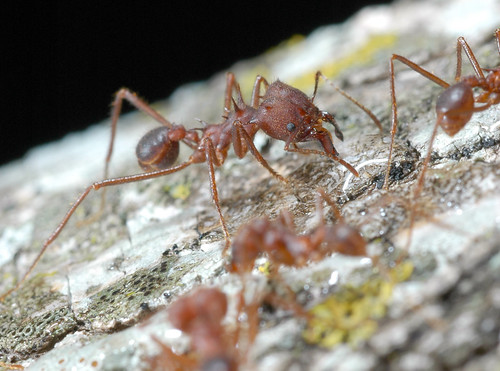
Like ants leaving a scent trail for other ants to follow, cyclists can follow the trail of other cyclists with the Contrail Biking Community Tool designed by Pepin Gelardi and Teresa Herrmann for a competition.
A doodad deposits chalk powder on the rear tire, which in turn leaves a trail of chalk on the road showing the bicycle's path on the road.

As more cyclists ride along the chalk marked route, the routes become more visible to cyclists and motorists, just like ant trails are reinforced as more ants use the path.

I really like this, though I hope I'm not directly behind a cyclist using one of these -- it could be pretty bad for the asthma. Doobybrain describes this concept as useful for showing cyclists where to "ride safely and out of the way of vehicular traffic," but the illustration above accurately portrays that the safest place can be in the lane with vehicular traffic if lane width warrants it. Gutter bunnies are dead bunnies.
More discussion at Bike Hacks and Streetsblog. Hat tip: Jamie in Columbus.
6 comments:
I personally don't think that spreading chalk on the roads is really the greatest idea. I wouldn't really expect enough people to actually buy this device to make it look like anything more than a few lines of chalk around on a regular basis either.
However, what would be really effective is if a group of people all rode together through a specified route to make the appearance of some sort of lane. But I wouldn't ever expect this to change drivers' behavior one bit. It's just a neat art piece.
One unfortunate benefit this would have, is that someone using a contrail that is struck by a vehicle could use it to their advantage (or possibly used against them too). You could easily point out exactly where they were riding, exactly what manuevers they attempted (swerving, etc), and exactly where they stopped.
Andy, your thought about using a contrail for crash investigation is GENIUS, IMO. It could show if "he swerved right into me" really happened or not.
See the clouds of choking chalk dust at the ATOC? Photoshopped demo picture be damned.
I'd be all for it if they had a design that was compatible with a full fender in the back. But I think my bike would just end up with a derailleur full of chalk.
oh wow, I had no idea. thanks for posting these, those rubber things are really taking off.
though I used to be a great advocate of cat-eyes, it has recently upset me some. my front light has died on me often mid-rides during light-rain weather. which at first, I stopped to buy new batteries, and that wasnt the issue. Ill have to read around more about that, but it sure upsets you when you cant do much afterhours w/o a light...
meligrosa mentioned having some trouble
with Cateye headlights.
I suggest checking the batteries contacts
and the battery holders contacts, to see
if there is any corrosion.
As much as is reasonable and feasible
and economical, I refuse to have single
points of failure for safety critical items,
such as head lights and tail-lights.
I always make sure whenever I ride that
I have at least two of each, both working
at the outset at least. I've pretty much
settled on Cateye HL-500 series headlights
as a good compromise between battery
drain, brightness, and economics. They
work so well, that I've taken to using
them around the house in most situations
where I would use a flashlight.
In many cases I also carry a 3-watt LED
handheld flash light, that can be pressed
into service if necessary as a surrogate
headlight.
On top of all that I also usually carry a
spare fully charged set of batteries.
When it could be my life that is at stake,
I think that carrying around about three
ounces worth of spare batteries is very
reasonable.
Post a Comment